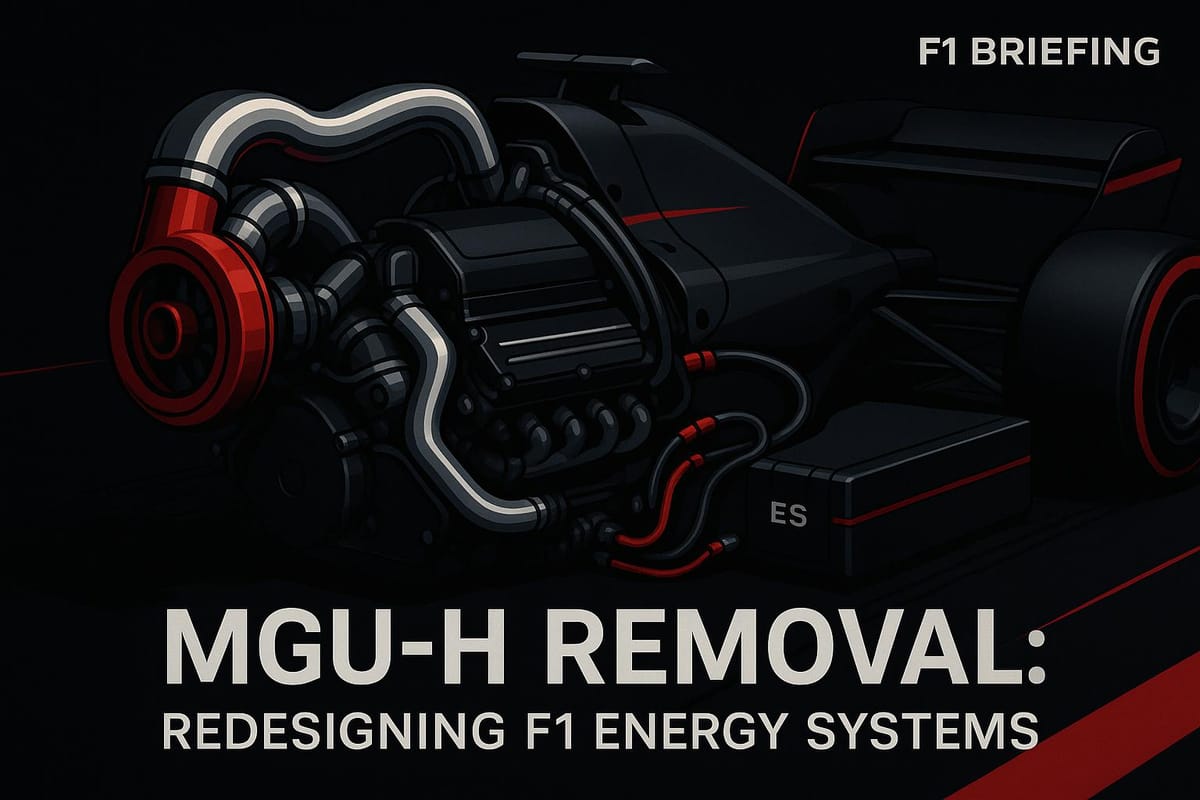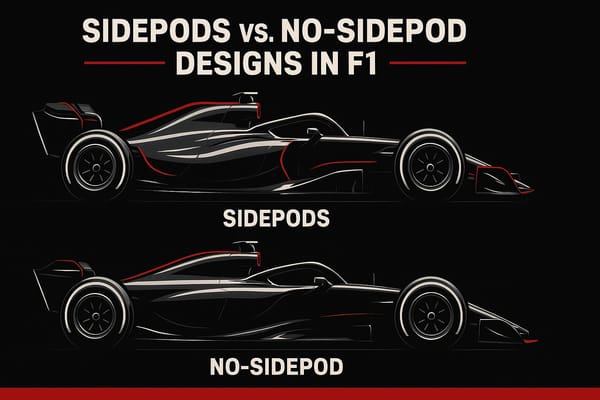MGU-H Removal: Redesigning F1 Energy Systems
Formula 1's 2026 overhaul simplifies energy systems by removing the MGU-H, enhancing sustainability, and inviting new competitors to the sport.

Formula 1 is set to undergo a major overhaul in 2026 with the removal of the MGU-H, a key component of its hybrid power units since 2014. This change simplifies the energy recovery system by focusing solely on the MGU-K, which will see its output jump from 120 kW to 350 kW, doubling energy recovery capacity to 8.5 megajoules per lap. The shift also introduces 100% sustainable fuels, aligning F1 with global efforts to reduce emissions.
Key Changes for 2026:
- MGU-H Removed: Ends heat recovery from exhaust gases.
- Upgraded MGU-K: Power increases from ~160 hp to ~470 hp.
- Energy Recovery Doubles: From ~4.25 MJ to 8.5 MJ per lap.
- Simplified Design: Reduces costs and attracts manufacturers like Audi and Honda.
- Sustainable Fuels: Mandatory use of non-food biomass and waste-derived fuels.
The removal of the MGU-H simplifies power units, cutting costs and addressing reliability issues that plagued manufacturers like Renault and Honda. However, the trade-off is the potential return of turbo lag, requiring teams and drivers to adjust strategies and driving techniques. With a 50-50 split between electric and combustion power, F1 aims to balance performance with reduced environmental impact.
This marks a fresh chapter for the sport, offering opportunities for new entrants while leveling the playing field for all teams.
Why Is The F1 MGU-H Being Removed? - Pole Position Experts
1. Energy Recovery Systems Before 2026
Before 2026, Formula 1 relied on a hybrid system that combined kinetic and thermal energy recovery, pushing the boundaries of efficiency while presenting significant challenges for manufacturers. Let’s break down the technical details that defined this era of energy systems.
Energy Recovery Methods
The pre-2026 F1 power units were built around two key components: the MGU-K (Motor Generator Unit – Kinetic) and the MGU-H (Motor Generator Unit – Heat). The MGU-K captured energy generated during braking and converted it into electrical energy, which was then stored in the battery for later use.
The MGU-H, on the other hand, recovered heat from the exhaust gases flowing through the turbocharger. This heat could be transformed into electrical energy to charge the battery, directly power the turbocharger to reduce lag, or send energy to the MGU-K.
These systems worked alongside a 1.6-liter V6 turbocharged internal combustion engine, forming a hybrid power unit that achieved thermal efficiency rates of over 50% in certain configurations - a milestone for internal combustion technology.
Electrical Output
The electrical output of this system was impressive, with the MGU-K consistently delivering 120 kW (around 160 horsepower). This power could be deployed during acceleration phases, providing an extra boost for overtaking or exiting corners. Meanwhile, the MGU-H’s output fluctuated based on exhaust temperatures, turbocharger demands, and team strategies.
| System Component | Primary Function | Power Output | Energy Storage |
|---|---|---|---|
| MGU-K | Recovers braking energy | 120 kW (≈160 hp) | Battery storage |
| MGU-H | Recovers heat from exhaust | Variable | Direct deployment or battery |
This setup showcased the potential of hybrid systems but also highlighted the challenges of integrating such advanced technology into a competitive racing environment.
Complexity and Cost
The complexity of these energy recovery systems posed a significant hurdle for manufacturers. The MGU-H, in particular, required advanced engineering to efficiently capture heat, eliminate turbo lag, and ensure smooth energy transfer between components. Mercedes quickly established itself as a leader in this area, gaining a competitive edge through superior integration and reliability. Meanwhile, Honda and Renault faced ongoing issues with reliability and energy management, forcing them to make substantial investments to catch up.
The costs associated with developing and manufacturing these systems were another major challenge. Specialized materials, intricate control mechanisms, and extensive testing drove up expenses, especially for the MGU-H. These financial and technical barriers played a key role in the regulatory shift toward simpler systems.
Environmental Impact
These hybrid systems also had an impact on F1’s environmental footprint. They delivered better fuel efficiency and reduced emissions compared to the older naturally aspirated engines. By combining the MGU-K and MGU-H, teams achieved meaningful gains in efficiency. However, these benefits were limited by the continued use of fossil fuels and the resource-intensive manufacturing processes required for such complex components. While the technology marked a step forward, the environmental improvements were incremental rather than game-changing.
Despite these limitations, the pre-2026 hybrid systems positioned Formula 1 as a leader in hybrid technology within motorsport, even as the sport’s broader environmental goals remained constrained by the technological and regulatory framework of the time.
2. Energy Recovery Systems After 2026
The 2026 regulations mark a major shift in Formula 1's energy recovery strategy, replacing the dual-system setup with a more streamlined, kinetic-focused design. With the removal of the MGU-H, the MGU-K will now serve as the sole energy recovery system.
Energy Recovery Methods
From 2026 onward, energy recovery in Formula 1 will rely entirely on kinetic energy, captured through the MGU-K. This change eliminates exhaust heat recovery and places greater emphasis on maximizing the efficiency of the single system. While the core concept remains familiar, teams will need to adapt to this simplified setup, particularly to compensate for the reintroduction of turbo lag. Drivers, too, will need to adjust their techniques, especially during corner exits, to accommodate these changes.
Electrical Output
The 2026 regulations bring a significant increase in the MGU-K's capabilities. Its maximum output will nearly triple, rising from 120 kW to 350 kW. This translates to a jump in electrical assistance from about 160 hp to 470 hp. Additionally, energy recovery per lap will double, allowing up to 8.5 megajoules (MJ) to be captured. To enhance overtaking opportunities, a Manual Override feature will enable drivers to deploy extra energy when needed.
| Power Unit Component | Current Output | 2026 Output | Change |
|---|---|---|---|
| MGU-K Power | 120 kW (~160 hp) | 350 kW (~470 hp) | +192% |
| Energy Recovery per Lap | ~4.25 MJ | 8.5 MJ | +100% |
| Electric Power Share | ~20% | ~50% | +150% |
Complexity and Cost
Eliminating the MGU-H not only simplifies the power unit's design but also reduces costs. These regulatory changes have already attracted new participants, such as Audi and Honda, who plan to join or rejoin Formula 1 in 2026. By focusing on energy storage and MGU-K optimization, manufacturers can align their efforts more closely with technologies relevant to road cars. This shift also promises better reliability and lower operational expenses, building on the lessons learned from the previous dual-system setup.
Environmental Impact
The new energy recovery system underscores Formula 1's commitment to sustainability. Starting in 2026, the sport will mandate the use of 100% sustainable fuel derived from non-food biomass, waste, or carbon capture. To ensure compliance, the FIA will implement a verification system for all fuel components. Additionally, battery recycling will be required under the new regulations.
The hybrid power units of 2026 are expected to achieve a near 50-50 split between electric and internal combustion power. The internal combustion engine will generate around 540 horsepower, while the MGU-K will contribute approximately 470 horsepower. This balance highlights Formula 1's dedication to electrification without compromising performance. Furthermore, the sustainable fuel initiative is designed as a "drop-in" solution, meaning it could be used in standard road cars without requiring modifications. This approach showcases how Formula 1's advancements can ripple out to benefit the broader automotive industry.
Advantages and Disadvantages
Switching to a single MGU-K system brings cost savings and a simpler design, but it also introduces new challenges. By looking at how energy recovery systems have evolved, it's clear that each setup comes with its own set of benefits and hurdles, shaping team strategies for both power unit development and race-day tactics.
Pre-2026 System Strengths and Weaknesses
Before 2026, Formula 1 relied on a dual-system approach, combining the MGU-H for capturing energy from exhaust heat and the MGU-K for recovering kinetic energy. One major perk of the MGU-H was its ability to eliminate turbo lag, ensuring smooth power delivery - especially critical during corner exits.
But there was a downside. The complex integration of the MGU-H with the turbocharger made the system expensive and technically challenging. These barriers not only drove up costs but also discouraged some manufacturers from participating, paving the way for the simplified 2026 regulations.
2026 System Trade-offs
The upcoming 2026 setup focuses on cutting costs and reducing complexity, making Formula 1 more appealing to new manufacturers. For example, Audi and Honda have both committed to joining or rejoining the sport in 2026, citing the streamlined design as a major factor. This new architecture aligns with stricter sustainability goals while being less daunting to develop.
However, this simplicity comes with a trade-off. Without the MGU-H, turbo lag could make a comeback. Teams will need to rethink how they manage power delivery, and drivers may have to adapt their techniques - especially when accelerating out of corners.
| Criteria | Pre-2026 Advantages | Pre-2026 Disadvantages | 2026 Advantages | 2026 Disadvantages |
|---|---|---|---|---|
| Energy Recovery | Dual-source capture | Complex integration | Improved MGU-K efficiency | Reliance on single source |
| Cost & Accessibility | Established technology | High development costs | Lower costs; attracts newcomers | Requires system redesign |
| Performance | Turbo lag eliminated | Reliability issues | 50% electric power contribution | Possible turbo lag return |
| Environmental Impact | Hybrid efficiency gains | Limited focus on sustainability | 100% sustainable fuel; net zero CO₂ | Transition challenges |
| Technical Complexity | Maximized energy use | Highly complex systems | Simplified architecture | No heat recovery |
Strategic Implications
This shift in technical and financial priorities will demand new strategies from teams. With the MGU-H gone, engineers can zero in on enhancing MGU-K efficiency and refining energy storage systems - an approach that mirrors advancements in road car technology.
Additionally, the introduction of a Manual Override feature will change how teams deploy energy during races, allowing for better management of the expanded recovery limits per lap. While this transition poses risks, it also levels the playing field. Established manufacturers that heavily invested in the MGU-H may lose their edge, while newcomers like Audi can enter the sport without the burden of outdated systems. For all teams, the simplified 2026 framework offers a fresh start with new opportunities to innovate.
Conclusion
The shift from dual-energy recovery systems to a single MGU-K setup represents more than just a technical adjustment - it's a strategic move that reflects Formula 1's evolving focus on sustainability and inclusivity. By removing the MGU-H, one of the sport's most intricate and costly components, Formula 1 has created opportunities for new and returning manufacturers like Audi and Honda to join the grid.
The increased output of the MGU-K and enhanced lap energy recovery are key upgrades in this transition. These changes not only deliver higher electrical power but also streamline the development and upkeep of power units. With power units now consisting of 50% electric components and running on sustainable fuels, the new system mirrors the broader automotive industry's push toward greener solutions.
For teams, this shift presents both opportunities and hurdles. Long-established manufacturers that heavily relied on MGU-H technology may lose some of their competitive edge, while newcomers stand to benefit from a more balanced playing field. Additionally, the updated environmental standards reinforce Formula 1's commitment to reducing its ecological footprint.
Drivers, on the other hand, will face adjustments such as managing potential turbo lag and adapting to revised energy deployment strategies. The cap of three power units per car per season will further ensure cost control while maintaining competitive fairness.
Expert voices also emphasize the significance of these changes.
Bob Bell has noted the sweeping scope of the 2026 regulations, which will impact both chassis and power unit design.
These regulatory updates highlight Formula 1's dedication to cost efficiency, sustainability, and attracting more manufacturers. The 2026 season marks a pivotal moment - not just in technical terms, but as a step toward a more accessible and environmentally responsible future for the sport.
FAQs
How will removing the MGU-H affect F1 teams’ performance and strategies?
The decision to remove the MGU-H from the 2026 F1 regulations represents a major change in how energy systems are designed, directly influencing both team strategies and car performance. The MGU-H has been a key component for efficiently recovering and deploying energy, so its absence will force teams to rethink how they approach power unit design.
This shift is expected to impact engine efficiency, energy recovery techniques, and even the overall design of the cars. Teams will also need to rework their race strategies, with energy management becoming an even bigger factor in staying competitive on the track.
What impact will the use of 100% sustainable fuels in 2026 have on Formula 1's environmental footprint?
The move to introduce 100% sustainable fuels in Formula 1 by 2026 is set to play a key role in cutting the sport's carbon emissions. These fuels are designed to be carbon-neutral, meaning the carbon dioxide emitted during combustion is balanced by the amount absorbed during their production.
While the spotlight is on slashing emissions during races, the bigger picture includes other factors, like how the fuels are produced and the logistics involved in transporting them. This initiative ties into F1’s larger goal of reaching net-zero carbon emissions by 2030, marking an important step toward reducing the sport's environmental impact.
What challenges could drivers face with the possible return of turbo lag in the 2026 power unit design?
The 2026 F1 power unit regulations will see the removal of the MGU-H, a change that could bring back an old challenge for drivers: turbo lag. Turbo lag refers to the delay in power delivery caused by the time it takes for the turbocharger to spool up, and it could make precise throttle control trickier - especially during corner exits where immediate acceleration is key. This delay might also complicate overtaking, as drivers rely on quick bursts of power to make decisive moves.
To tackle this, teams will likely turn their attention to improving engine mapping and optimizing turbocharger designs to reduce the lag as much as possible. Meanwhile, drivers may need to tweak their driving techniques, learning to anticipate the lag and adapt their approach to maintain their edge on the track.




